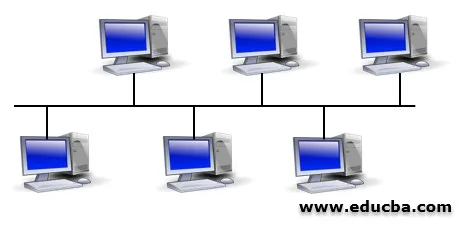
What is Ethernet Topology?
The IEEE 802.3 standard is famously called as ethernet. It provides a decentralized control on the broadcast network on a bus-based topology. It can execute at 10Mbps or 100Mbps or higher than that. The Ethernet connection to the server can conduct as per the process. If multiple machines transmit at the same time, then the probability of collision is high. The computer which transmits just pause for a considerable time and retransfer the signal. So there are different techniques which are available in the LAN market and the most popular one is ethernet. The types of use, merits, and demerits of Ethernet topology are discussed in this article.
Types of Ethernet Topology
The different types of ethernet topology are ring, bus, mesh, hybrid and star topology.
1. Mesh Topology

In the mesh topology, every device is associated with other components to form a network via dedicated or concern point to point link. The concern link denotes that only transmits data for only two associated devices. Consider there are N devices in the entire network, the number of associated network components will be N-1. Then the number of links established in the mesh topology of N devices would be N(N-1)/2.
There are no traffic issues created at data flow which is concerned between two components that means the link connection is available only for the dedicated two devices. It is robust and reliable which doesn’t impact the other links and interaction between the other component in the network.in the mesh topology, there are many easy fault detection methods. It is a secure method as there is a point to point link because of the impossible unauthorized access. The quantity of wires needed to link every system is monotonous and each device requires many numbers of I/O ports. The scalability issues are developed because the huge number of devices is connected to a concerning point to point link.
2. Star Topology

In the star topology, the network component is controlled by a central management component called the hub. The star topology doesn’t enable any direct connection between devices, every single data is communicated via the central hub component. If any component from the network wants to send a message to other devices then it should be transmitted via a hub to the designated hub. Star topology provides only minimum expense and requires a single I/O port which should be connected to a hub with only one link. It is easy to implement and requires only less amount of cable. It provides a robust process if any one link fails, it isolates from the rest of the network and the productivity doesn’t get affected. The fault detection process is simple and the affected part can be easily identified. The hub needs many resources and periodic maintenance as it is the central management of the entire network.
3. Bus Topology

In the bus topology, all the components are connected to the main cable via drop lines. The main device is called a tap which links the drop wire to the main wire. Since all the information over the main cable is transmitted, there is a constraint of drop lines and a distance of the main cable. The installation of bus topology is an easy process that is associated via backbone cable. Comparing to Mesh and star topology, it requires only a few wires. Since there is a limit of how many numbers of nodes connected with backbone cable, here the fault is difficult to be detected and it also becomes non-scalable. Popular Course in this categoryAll in One Software Development Bundle (600+ Courses, 50+ projects)600+ Online Courses | 3000+ Hours | Verifiable Certificates | Lifetime Access
4.6 (3,144 ratings)Course Price
₹8999 ₹125000
View Course
Related CoursesWindows 10 Training (4 Courses, 4+ Projects)JWS Java Web Services Training (4 Courses, 11 Projects)Java Training (40 Courses, 29 Projects, 4 Quizzes)
4. Ring topology

Ring topology is a device linked to two or multiple devices either one or two sides connected to s network. There is a dual dedicated point to point links a component with the component on both sides. The structure of the ring topology sends a unidirectional flow of data. It connects a repeater which forwards the data often and keeps on intending the server until it receives the data. The installation of ring topology is simple. The addition or removal of the device from the topology is easy and it can be changed frequently whenever it required. The failure of links breaks the working of the entire network and the process gets stopped. The data traffic issues are created as there is only one direction of the flow of data.
5. Hybrid Topology

The combination of two topologies is called as hybrid topology. For example, the hybrid topology is formed by the merging of mesh and star topology. The hybrid topology can be formed according to the requirement concerning scalability and productivity. But the detection of fault is complex and installation is a tedious process. There is a complex design and the deployment requires expensive cost.
Why Do We Use Ethernet Topology?
The Ethernet operates on a logical bus topology. All the components on the network share the same medium and are detected based on the MAC address. Due to the shared component, the multiple components transfer at the time of data collisions. It is managed by CD/CSAM protocol and the components monitor the media because of the existence of digital signal. If there is an absence of a data signal, it represents that the media is free and transmits the data. so if the signals are identified, it shows that another device is transferring the data at the same time. Now all the devices stop its functions and try to transmit later. Also, a note to be made is that many of the LAN are full-duplex and the transmission of data is managed by the intermediate components, without any protocol.
Advantages and Disadvantages
The merits of ethernet topology are:
- It is an inexpensive method to attain a maximum speed LAN transmissions.
- The ethernet topology supports many wiring configurations which are reliable and flexible.
- Deployment and installation are easy.
- The efficiency of ethernet topology is maximum in a huge number of LAN and micro applications to mainframe applications.
The demerits of Ethernet topology:
It doesn’t perform well in high-load environments and this protocol restricts down the working of hundreds of servers which is operating at the same cabling path.
Recommended Articles
This is a guide to Ethernet Topology. Here we also discuss the Introduction and why we use the ethernet topology along with advantages and disadvantages. You may also have a look at the following articles to learn more –
ALL IN ONE SOFTWARE DEVELOPMENT BUNDLE (600+ COURSES, 50+ PROJECTS) 600+ Online Courses 3000+ Hours Verifiable Certificates Lifetime AccessLearn More0SHARESShareTweetSharePrimary Sidebar
Computer Tutorial
- Computer Basics
- New Technologies Of Computer
- Application Of Computer Graphics
- Types Of Computer Architecture
- Types Of Computer Software
- Components Of Computers
- Computer Input Devices
- Line Drawing Algorithm
- SOAP Web Services Interview Questions
- Web Services Interview Questions
- Microservices Interview Questions
- What Is Windows 10?
- Windows 10 Desktop Mode
- Windows Commands
- Windows Interview Questions
- Windows Networking Commands
- Windows Operators
- Windows Server Interview Questions
- Introduction To Windows
- Top Windows Phone Apps
- Windows Monitoring Tool
- Productivity Tricks For Windows 10
- Computer Network Advantages And Disadvantages
- Computer Network Interview Questions
- Introduction To Computer Network
- Metropolitan Area Network
- What Is Embedded Systems
- Components Of Embedded System
- Embedded Systems Security
- Types Of Computer Network
- Types Of Computer Operating System
- Evolution Of Operating System
- NAS Storage Device
- Windows Administrator Interview
- Types Of Communication Network
- What Is Automata
- Types Of Mainframe Computers
- Types Of Computer Hardware
- Types Of Sensors
- What Is Server
- What Is RPC
- What Is Microservices
- Types Of Computer Virus
- Types Of Computer Keyboard
- Types Of Motherboard
- Sensor Device
- What Is Computer Graphic Design
- Computer Architecture Interview
- What Is Computer Science?
- What Is Bluetooth?
- What Is VLAN?
- Types Of VLAN
- Types Of LAN
- How Does LAN Switches Work
- What Is VLAN Network?
- What Is Native VLAN?
- Switching Modes
- What Is Storage?
- What Is Object Storage?
- What Is Block Storage?
- Block Level Storage
- Cordova Local Storage
- Threads In Operating System
- What Is Gateway?
- What Is Ethernet?
- What Is Virtual Machine?
- What Is A Trunk Port?
- VPN Applications For Android
- What Is A NAS Drive?
- What Is Ring Topology?
- Point To Point Topology
- What Is Mesh Topology?
- Extended Star Topology
- Token Ring Topology
- Physical Topology
- What Is A Hybrid Topology?
- Hybrid Network Topology
- Star Network Topology
- Star Bus Topology
- Zariski Topology
- Ethernet Topology
- Logical Topology
- Partial Mesh Topology
- Types Of Computer Cables
- Types Of Computer Language
- Features Of Operating System
- Functions Of Operating System
- Multithreading In Operating System
- Ethernet Frame Format
- Types Of Memory In Computer
- What Is Heap Memory?
- Cache Memory
- Cache Memory Types
- Register Memory
- What Is Register?
- Types Of Registers
- What Is Arduino?
- Arduino Operators
- What Is ISCSI?
- Computer Science Interview Questions
- Types Of USB Ports
- What Is Port
- Daisy Chain Network
- What Is A Monitor?
- What Is Printer?
- Types Of Printers
- What Is WPS
- What Is Mouse?
- Types Of Mouse
- Types Of Socket
- Transmission Modes
- Computers Output Devices
- Memory Units
- Secondary Memory
- What Is Memory Card?
- Types Of Memory Cards
- What Is Intranet?
- Central Processing Unit
- Computer Ports
- What Is CPU Register
- Types Of CPU
- Types Of Compact Disc
- What Is A Motherboard?
- Types Of LED
- Types Of Processor
- Types Of Primary Memory
- Helpdesk Tool
- What Is Optical Fiber?
- Windows 10 Creation Tool
- Unguided Media Types
- Microcontroller Architecture
- ARM Architecture
- What Is NVME?
